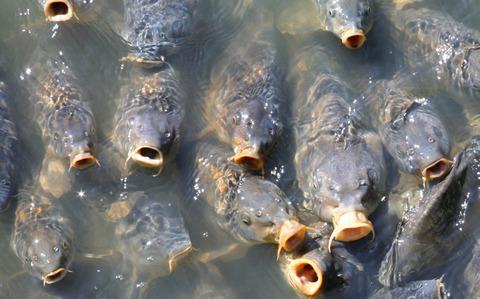当前位置:
X-MOL 学术
›
J. Appl. Ecol.
›
论文详情
Our official English website, www.x-mol.net, welcomes your feedback! (Note: you will need to create a separate account there.)
Genetic variation in resistance and high fecundity impede viral biocontrol of invasive fish
Journal of Applied Ecology ( IF 5.7 ) Pub Date : 2020-10-14 , DOI: 10.1111/1365-2664.13762 Kate S. Mintram 1 , Cock Oosterhout 2 , Jackie Lighten 1
中文翻译:

抗性和高繁殖力的遗传变异阻碍了入侵鱼类的病毒生物防治。
更新日期:2020-10-14
Journal of Applied Ecology ( IF 5.7 ) Pub Date : 2020-10-14 , DOI: 10.1111/1365-2664.13762 Kate S. Mintram 1 , Cock Oosterhout 2 , Jackie Lighten 1
Affiliation

|
- Common carp Cyprinus carpio is one of the top global invasive vertebrates and can cause significant ecological damage. The Australian Government's National Carp Control Program (NCCP) proposes to release Koi herpesvirus (KHV) to eradicate feral carp in one of the largest ecological interventions ever attempted. Ecological and human health risks have been highlighted regarding the release of a highly pathogenic viral biocontrol for an aquatic species. The efficacy of KHV has also been questioned, and it has not been demonstrated to produce lasting population reductions.
- We developed an individual‐based model (IBM) to examine the ecological and evolutionary response of a carp population after KHV release. This simulated the interaction between fish life history, viral epidemiology, host genetic resistance and population demography to critically evaluate the impact of KHV release under optimal conditions and a ‘best‐case scenario’ for disease transmission.
- KHV will rarely result in prolonged reductions or population extinctions. Crucially, realistic scenarios result in a rapidly rebounding population of resistant individuals. Additional measures aimed to reduce carp population recovery rate (e.g. with genetic engineering) require rapid efficacy to significantly reduce carp numbers alongside KHV.
- Fish fecundity has an overwhelming influence on viral efficacy as a biocontrol agent when combined with genetic resistance within a population. A high probability of population extinction is only met when carp fecundity is reduced to 1% of biological observations.
- Synthesis and applications. We use an individual‐based model to evaluate the efficacy of Koi herpesvirus biocontrol in Common Carp, and find that high host fecundity combined with genetic resistance results in rapid population rebound after initial large fish kills. Biocontrol approaches relying on natural selection lose efficacy over successive generations as resistance genes increase in frequency. Given the intense logistical effort and risks to ecosystems and human health associated with large fish kills after viral release, we suggest that sustained manual removal, alongside ecological restoration to favour recovery of native species, provides a risk‐free approach to reducing populations.
中文翻译:

抗性和高繁殖力的遗传变异阻碍了入侵鱼类的病毒生物防治。
- 鲤鱼鲤鱼是全球最主要的入侵脊椎动物之一,可造成重大的生态破坏。澳大利亚政府的国家鲤鱼控制计划(NCCP)建议释放锦鲤疱疹病毒(KHV),以消灭野生鲤鱼,这是有史以来规模最大的生态干预措施之一。关于对水生物种释放高致病性病毒生物控制的生态和人类健康风险已得到强调。KHV的功效也受到质疑,并且尚未证明可持久减少人口。
- 我们开发了基于个人的模型(IBM),以检查KHV释放后鲤鱼种群的生态和进化反应。这模拟了鱼类生活史,病毒流行病学,宿主遗传抗药性和种群人口统计学之间的相互作用,以严格评估在最佳条件下KHV释放的影响以及疾病传播的“最佳情况”。
- KHV很少会导致持续减少或灭绝。至关重要的是,现实情况导致抵抗力个体迅速反弹。旨在降低鲤鱼种群恢复率的其他措施(例如,通过基因工程)要求快速有效地与KHV一起显着减少鲤鱼数量。
- 与种群内的遗传抗性相结合时,鱼类的繁殖力对作为生防剂的病毒功效具有压倒性的影响。只有将鲤鱼的繁殖力降低到生物学观察值的1%时,才有可能实现种群灭绝。
- 综合与应用。我们使用基于个体的模型来评估锦鲤疱疹病毒在鲤鱼中的生物防治效果,并发现高宿主繁殖力和遗传抗性导致最初的大鱼死亡后种群快速反弹。随着抗性基因频率的增加,依赖自然选择的生物防治方法在连续几代中失去效力。鉴于大量的后勤工作以及病毒释放后与大量鱼类死亡相关的生态系统和人类健康风险,我们建议持续的人工清除以及生态恢复有利于本地物种的恢复,为减少种群提供了一种无风险的方法。


























 京公网安备 11010802027423号
京公网安备 11010802027423号